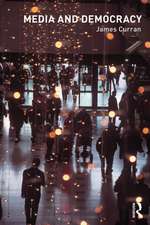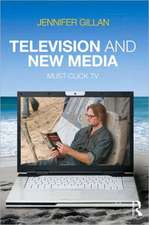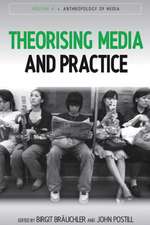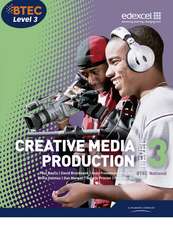European Media in the Digital Age: Analysis and Approaches
Autor Richard Rookeen Limba Engleză Hardback – 9 feb 2015
The text is pedagogically rich and explores a variety of approaches to help the reader gain a better understanding of the European media world. Students are encouraged to start thinking about statistics, relating this to economics, analysing regulations, and combining media theories with theories of European Union integration. The book also includes the use of case studies, illustrations, summaries, critical reflections and directions to wider reading.
The European Media in the Digital Age is recommended for all Media Studies students and is also of key interest to students of Politics and Policy, Business Studies, International Studies and European Studies
| Toate formatele și edițiile | Preț | Express |
|---|---|---|
| Paperback (1) | 393.26 lei 6-8 săpt. | |
| Taylor & Francis – 2 apr 2009 | 393.26 lei 6-8 săpt. | |
| Hardback (1) | 683.04 lei 6-8 săpt. | |
| Taylor & Francis – 9 feb 2015 | 683.04 lei 6-8 săpt. |
Preț: 683.04 lei
Preț vechi: 803.57 lei
-15% Nou
Puncte Express: 1025
Preț estimativ în valută:
130.70€ • 136.83$ • 108.15£
130.70€ • 136.83$ • 108.15£
Carte tipărită la comandă
Livrare economică 05-19 aprilie
Preluare comenzi: 021 569.72.76
Specificații
ISBN-13: 9781138836846
ISBN-10: 1138836842
Pagini: 288
Ilustrații: illustrations
Dimensiuni: 189 x 246 mm
Greutate: 0.82 kg
Ediția:1
Editura: Taylor & Francis
Colecția Routledge
Locul publicării:Oxford, United Kingdom
ISBN-10: 1138836842
Pagini: 288
Ilustrații: illustrations
Dimensiuni: 189 x 246 mm
Greutate: 0.82 kg
Ediția:1
Editura: Taylor & Francis
Colecția Routledge
Locul publicării:Oxford, United Kingdom
Cuprins
1. The EU and the media - EU media policy and globalisation Inroduction: the EU and the media in the 21st century. The EU, globalisation and media. The EU and localisation. Glocalisation. The EU and ‘Europanisation’. Defining and understanding the EU. Europe and the EU: contexts for media policy. The EU institutions, policy-making and the media. The structure of the EU. Other direct and indirect pressures on the EU media. Chapter summary. Key terms. Discussion questions. Assignments. Further reading. Online resources. References. Appendix 2. Understanding EU media through data - statistics Introduction: The media and data. Sources. Statistics. Preliminary investigation: are newspapers and print products in decline in the EU? The context and the data questions: using qualitative methods. Linear and non-linear ways of looking at data. Chapter summary. Key terms. Discussion questions. Assigments. Further reading. Online resources. References 3. Understanding EU media through economics Introduction: economics and the media. The macro and the micro. Supply of and demand of goods. Price and costs (fixed and variable) and equilibrium. Market definitions. Chapter summary. Key terms. Discussion questions. Assignments. Further reading and references. Online resources 4. EU politics, regulation and media legislation Introduction: regulation and the regulators. The EU regulatory debate. The European regulatory context. Public vs private. International rules and the EU. EU regulatory development – key areas. Moving on into the 21st century. EU member state national regulation. Regulation, deregulation, self-regulation and co-regulation. Conclusions and more questions. Chapter summary. Key terms. Discussion questions. Assignments. Further reading. Online resources. References 5. Media theory in the European context Introduction: using theory. Media theory and European integration. Context: the theories of European integration and media development – some contexts. Debates on the EU theories of integration. Media and communication theory. Using theory with research methods. Critical review. Media theory milestones and contemporary debates. Chapter summary. Key terms. Discussion questions. Assignments. Further reading. Online resources. References 6. Production in the EU press and publishing industry Introduction: The European media landscape – analysing the market. History and precedents. The 20th century. The contemporary era: the 21st century. Publishing markets and production. The present scene: an indication. Comparative work: finding the variables (the comparators). Chapter summary. Key terms. Discussion questions. Assignments. Further reading. Online resources. References 7. The distribution of print and published material Introduction: the print industry. Distribution. Classic vs new distribution techniques. Distribution: European policy. Distribution: national policies – a comment. Chapter summary. Key terms. Discussion questions. Assignments. Further reading. Online resources. References 8. The consumption of print and published material Introduction: assessing the material available to researchers for the publishing industry - the data. Interpretation and judgement. European consumption and trends. Reflections. Chapter summary. Key terms. Discussion questions. Further reading. Online resources. References 9. Audio-visual content in the EU: Production and scheduling (by Andrea Esser) Introduction: analysing audiovisual programming in the EU. Sources. History and precedents. The 1980s. Changes in content production. Financing. Entertainment on our television screens: production, acquisition, scheduling. The rise of formats. Other programming trends in the new millennium: added-value, textual convergence and interactivity. Chapter summary. Key terms. Discussion questions. Assignments. Further reading. Online resources. References 10. The distribution network of the audio-visual in the EU Introduction: a period of change. Television and radio. Film. Classic vs new distribution techniques. Distribution: European policy. Distribution: national policies. The impact on public sector broadcasting. Chapter summary. Key terms. Discussion questions. Assignments. Further reading. Online resources. References 11. The consumption of audio-visual material in the EU: trends Introduction: assessing the material available to researchers for the audio-visual: industry - the data. Sources. Consumption: European trends. Consumption: national trends – an indication. EU National statistical agencies and the public-private divide. The future: a comment. Chapter summary. Key terms. Discussion questions. Assignments. Further reading. Online resources. References. Index
Descriere
This introductory textbook for Media and Communication Studies students is designed to encourage observation and evaluation of the European media in the digital age, enabling students to grasp key concepts and gain a broad and clear overview of the area. It also introduces the principal debates, developments (legislative, commercial, political and technological) and issues shaping the European media today, and examines in depth the mass media, digital media, the internet and new media policy. Understanding today’s media scene from print to audiovisual needs a wider view and this book helps make comprehensible the European media within a broader global media landscape.
The text is pedagogically rich and explores a variety of approaches to help the reader gain a better understanding of the European media world. Students are encouraged to start thinking about statistics, relating this to economics, analysing regulations, and combining media theories with theories of European Union integration. The book also includes the use of case studies, illustrations, summaries, critical reflections and directions to wider reading.
The European Media in the Digital Age is recommended for all Media Studies students and is also of key interest to students of Politics and Policy, Business Studies, International Studies and European Studies
The text is pedagogically rich and explores a variety of approaches to help the reader gain a better understanding of the European media world. Students are encouraged to start thinking about statistics, relating this to economics, analysing regulations, and combining media theories with theories of European Union integration. The book also includes the use of case studies, illustrations, summaries, critical reflections and directions to wider reading.
The European Media in the Digital Age is recommended for all Media Studies students and is also of key interest to students of Politics and Policy, Business Studies, International Studies and European Studies













